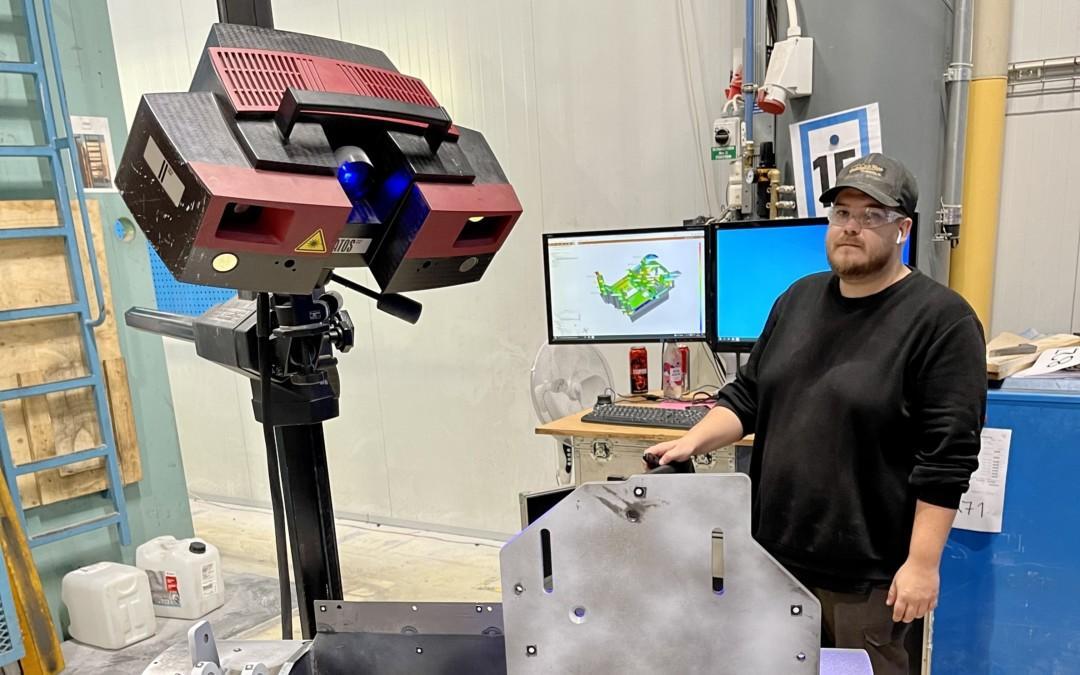Small inaccuracies may appear insignificant on paper, but a measurement being even a millimetre off – a component that is half a degree out of alignment, wear in the welding jig or a measurement error, for example – is significant in terms of the end result. Earlier on, parts and wear were measured by hand but 3D solutions have since then facilitated the work and improved the resulting quality significantly. This also increases the efficiency of the production process, as it helps detect deviations at the factory.
Relicomp is already actively using 3D measurement in production and design, according to Designer Sami Latva-Krekola. He has become familiar with the measurement needs of production over a long period of time, since he used to work at Relicomp’s production unit in deep drawing, incremental forming, laser processes and 3D measurement. Now, his work mainly consists of designing welding jigs and other tools for in-house production and parts for larger customer projects.
3D measurement has a considerable impact on work and it can be used to verify that manufactured products match the customer’s model down to the last detail:
“If a component is even a fraction of a millimetre off compared to the model, the system points this out immediately and the production changes can be made right away at the factory. This eliminates the need for attempting to fit prototype parts together, as any errors are spotted during modelling. Assembly is also more effective because the parts are exactly as they should be,” says Sami in reference to the benefits of 3D measurement.
3D measurement ensures consistent quality most of all
The most notable benefit of 3D measurement is consistent quality. The measurement device indicates precisely whether or not every aspect adheres to the customer’s 3D model. The system reveals even the smallest of discrepancies immediately. Adjusting the welding jig ends up exactly as the customer ordered. Without 3D measurement this would be nearly impossible:
“Without a 3D measuring device, the parts would be measured and fitted by hand, which would be extremely difficult, especially with complex parts. For example, the shape of our deep-drawn products makes manual measurement impossible. In these cases, the customer would need to try and fit the finished parts directly in the machine and we would then make adjustments where necessary. 3D measurement ensures that the fitting phase is not required and we can immediately see the problem areas,” Sami says.
As a result, 3D measurement is used extensively in the quality monitoring of Relicomp’s own production devices. Heavy-duty industrial use inevitably wears down equipment, but measurements ensure that parts wear, and its impacts on production quality, is detected quickly. This means that customers get consistent quality every time. For example, the regular inspection of welding jigs’ mating surfaces ensures that the jigs, their surfaces and the parts always produce the same level of quality.
Corresponding equipment measurements are sometimes also conducted for customers who do not yet have their own 3D measurement solutions. However, 3D systems are becoming more commonplace and many Relicomp customers now have them.
“If the customer has the same ATOS system as we do, we can measure the parts here and send the measurement data over. This means that the customer can check and test the part before we ship it anywhere. Parts intended for new assemblies can be fitted together and tested in the system immediately. If the customer company does not have a system of its own, we can prepare and send measurement reports to the customer instead. The reports indicate the offsets and shape of the component. Similarly, if the customer has had issues with parts, we can measure series parts and send the measurement data over. This way, the customer can examine the data and compare it against in-house models,” Sami says.




